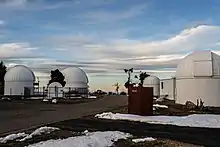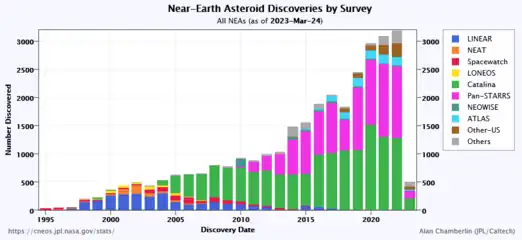Catalina Sky Survey
Catalina Sky Survey (CSS; obs. code: 703) is an astronomical survey to discover comets and asteroids. It is conducted at the Steward Observatory's Catalina Station, located near Tucson, Arizona, in the United States.
 | |
| Alternative names | CSS |
|---|---|
| Coordinates | 32°25′01″N 110°43′59″W |
| Observatory code | 703 |
| Website | catalina |
| see § List of discovered minor planets |
CSS focuses on the search for near-Earth objects, in particular on any potentially hazardous asteroid that may pose a threat of impact. Its counterpart in the southern hemisphere was the Siding Spring Survey (SSS), closed in 2013 due to loss of funding. CSS supersedes the photographic Bigelow Sky Survey.
Mission

|
LINEAR NEAT Spacewatch LONEOS |
CSS Pan-STARRS NEOWISE All others |
The NEO Observations Program is a result of a United States 1998 congressional directive to NASA to begin a program to identify 1 kilometre (0.62 miles) or larger objects to around 90 percent confidence level or better. The Catalina Sky Survey, located at the Mount Lemmon Observatory in the Catalina Mountains north of Tucson, carries out searches for near-earth objects, NEOs, contributing to the congressionally mandated goal.
In addition to identifying impact risks, the project also obtains other scientific information, including: improving the known population distribution in the main belt, finding the cometary distribution at larger perihelion distances, determining the distribution of NEOs as a product of collisional history and transport to the inner Solar System, and identifying potential targets for flight projects.
Techniques
The Catalina Sky Survey (CSS) uses three telescopes, a 1.5 meters (59 in) f/1.6 telescope on the peak of Mount Lemmon (MPC code G96), a 68 cm (27 in) f/ 1.7 Schmidt telescope near Mount Bigelow (MPC code 703), and a 1-meter (39 in) f/2.6 follow-up telescope also on Mount Lemmon (MPC code I52). The three telescopes are located in the Santa Catalina Mountains near Tucson, Arizona. The CSS southern hemisphere counterpart, the Siding Spring Survey (SSS), used a 0.5 meters (20 in) f/3 Uppsala Schmidt telescope at Siding Spring Observatory in Australia. The 1.5 meter and 68 cm survey telescopes use identical, thermo-electrically cooled cameras and common software written by the CSS team. The cameras are cooled to approximately −100 °C (−148 °F) so their dark current is about 1 electron per hour. These 10,560 x 10,560 pixel cameras provide a field of view of 5 square degrees with the 1.5-m telescope and nearly 20 square degrees with the Catalina Schmidt. Nominal exposures are 30 seconds and the 1.5-m can reach objects fainter than 21.5 V in that time.[2] The 1 meter follow-up telescope uses a 2k x 2k CCD detector which provides a field of view of 0.3 square degrees. Starting 2019, CSS started using the 1.54 meters (61 in) Kuiper telescope situated on Mt. Bigelow for targeted follow-up for 7–12 nights per lunation.
CSS typically operates every clear night with the exception of a few nights centered on the full moon. The southern hemispheres' SSS in Australia ended in 2013 after funding was discontinued.[3]
Discoveries
In 2005, CSS became the most prolific NEO survey surpassing Lincoln Near-Earth Asteroid Research (LINEAR) in total number of NEOs and potentially hazardous asteroids discovered each year since. As of 2020, the Catalina Sky Survey is responsible for the discovery of 47% of the total known NEO population. CSS discovered 310 NEOs in 2005, 396 in 2006, 466 in 2007, 564 in 2008, 573 in 2009, 607 in 2010, 572 in 2011, 626 in 2012, 600 in 2013, 616 in 2014, 576 in 2015, 929 in 2016, 989 in 2017, 1054 in 2018, and in 2019, 1067 NEOs were found.[4]
Notable discoveries
| Minor planet | Discovery date | Description |
|---|---|---|
| 2006 JY26 | May 6, 2006 | Near missed the Moon and the Earth on May 9–10, 2006, and may impact the Earth on May 3, 2073.[5] |
| 2007 WD5 | November 20, 2007 | Near missed Mars on January 9, 2008 [6][7] |
| 2007 TU24 | October 11, 2007 | Close approached Earth on January 29, 2008 [8] |
| 2008 TC3 | October 6, 2008 | Struck Earth on October 7, 2008 [9] |
| 2012 XE133 | December 12, 2012 | Currently a temporary co-orbital of Venus.[10] |
| 2014 AA | January 1, 2014 | Struck Earth on January 2, 2014.[11][12][13] |
| 2018 LA | June 2, 2018 | Struck Earth on June 2, 2018.[14] |
List of discovered minor planets
For a complete listing of all minor planets discovered by the Catalina Sky Survey, see the index section in list of minor planets.
CSS/SSS team
The CSS team is headed by Eric Christensen of the Lunar and Planetary Laboratory of the University of Arizona.[15]
The full CSS team is:
- Eric J. Christensen (principal investigator)
- Gregory Farneth
- Stephen M. Larson
- Alex R. Gibbs
- Albert D. Grauer
- Richard E. Hill (Retired)
- Richard A. Kowalski
- Joshua Hogan
- Hannes Gröller
- Frank Shelly
- David Rankin
- D. Carson Fuls
- Gregory J. Leonard
- Rob Seaman
- Theodore Pruyne
- Kacper Wierzchos
Educational outreach
The CSS has helped with Astronomy Camp showing campers how they detect NEOs. They even played a role in an astrophotography exercise with the 2006 Adult Astronomy Camp ending up with a picture that was featured on Astronomy Picture of the Day.[16]
Catalina Outer Solar System Survey
The Zooniverse project Catalina Outer Solar System Survey[17] is a citizen science project and it is listed as a NASA citizen science project.[18] In this project, the volunteers search for trans-Neptunian objects (TNOs) in pre-processed images of the Catalina Sky Survey. Computers can detect the motion of TNOs, but humans have to check if this motion is real.[19][20] Upon agreement with the volunteers, they will be cited as "measurers" in the submission of the astrometry to the Minor Planet Center.[21] The project already found previously known TNOs, including 47171 Lempo, (445473) 2010 VZ98, and (144897) 2004 UX10.[22]
See also
References
- "Minor Planet Discoverers (by number)". Minor Planet Center. 12 January 2017. Retrieved 2 February 2017.
- "Last night at G96 I have very good conditions, high transparency and sub-arcsecond seeing and for at least one NEO candidate at 21.8 V". yahoo.com. Retrieved 5 April 2018.
- Safi, Michael (20 October 2014). "Earth at risk after cuts close comet-spotting program, scientists warn". The Guardian. Retrieved 25 November 2015.
- NEO discovery statistics Archived 2017-04-03 at the Wayback Machine from JPL. Shows the number of asteroids of various types (potentially hazardous, size > 1 km, etc.) that different programs have discovered, by year.
- Steve Chesley, Paul Chodas and Don Yeomans (September 15, 2011). "2006 JY26 Earth Impact Risk Summary". NASA/JPL Near-Earth Object Program Office. Archived from the original on 2016-12-15. Retrieved 2013-05-11.
- "Catalina Sky Survey Discovers Space Rock That Could Hit Mars". Archived from the original on May 10, 2008. Retrieved 2007-12-22.
{{cite web}}: CS1 maint: unfit URL (link) - Steve Chesley, Paul Chodas and Don Yeomans (January 9, 2008). "2007 WD5 Mars Collision Effectively Ruled Out – Impact Odds now 1 in 10,000". NASA/JPL Near-Earth Object Program Office. Archived from the original on 2008-01-11. Retrieved 2008-01-09.
- "Asteroid to Miss Earth Tonight". The Washington Post. January 28, 2008. Retrieved 2008-01-28.
- "Asteroid to be harmless fireball over Earth". CNN. October 6, 2008. Retrieved 2008-10-07.
- de la Fuente Marcos, Carlos; de la Fuente Marcos, Raúl (June 2013). "Asteroid 2012 XE133, a transient companion to Venus". Monthly Notices of the Royal Astronomical Society. 432 (2): 886–893. arXiv:1303.3705. Bibcode:2013MNRAS.432..886D. doi:10.1093/mnras/stt454.
- "The First Discovered Asteroid of 2014 Collides With The Earth". NASA JPL. April 27, 2014. Archived from the original on February 11, 2017. Retrieved April 28, 2014.
- Farnocchia, Davide; Chesley, Steven R.; Brown, Peter G.; Chodas, Paul W. (August 1, 2016). "The trajectory and atmospheric impact of asteroid 2014 AA". Icarus. 274: 327–333. Bibcode:2016Icar..274..327F. doi:10.1016/j.icarus.2016.02.056.
- de la Fuente Marcos, C.; de la Fuente Marcos, R.; Mialle, P. (October 13, 2016). "Homing in for New Year: impact parameters and pre-impact orbital evolution of meteoroid 2014 AA". Astrophysics and Space Science. 361 (11): 358 (33 pp.). arXiv:1610.01055. Bibcode:2016Ap&SS.361..358D. doi:10.1007/s10509-016-2945-3. S2CID 119251345.
- "Tiny Asteroid Discovered Saturday Disintegrates Hours Later Over Southern Africa". NASA/JPL. Jet Propulsion Laboratory. Retrieved 14 Mar 2019.
- "Catalina Sky Survey – Directory". Lunar and Planetary Laboratory. Retrieved 3 February 2020.
- "APOD: 2006 August 31 – Extra Galaxies". antwrp.gsfc.nasa.gov. Retrieved 5 April 2018.
- Fuls, Carson. "Catalina Outer Solar System Survey". www.zooniverse.org. Retrieved 2020-08-25.
- "Citizen Science | Science Mission Directorate". science.nasa.gov. Retrieved 2020-08-25.
- Fuls, Carson. "Catalina Outer Solar System Survey >> Research – Zooniverse". www.zooniverse.org. Retrieved 2020-08-25.
- "Comb the Edges of the Solar System with the Catalina Outer Solar System Survey | Science Mission Directorate". science.nasa.gov. Retrieved 2020-08-25.
- Fuls, Carson. "Catalina Outer Solar System Survey >> FAQ – Zooniverse". www.zooniverse.org. Retrieved 2020-08-25.
- Fuls, Carson. "Catalina Outer Solar System Survey >> Results – Zooniverse". www.zooniverse.org. Retrieved 2020-08-25.